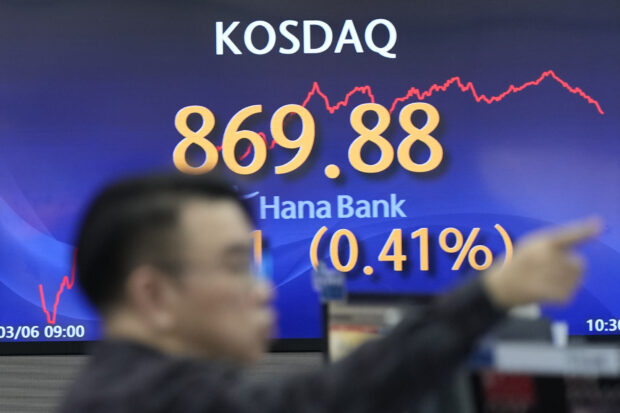
A currency trader gestures near screen showing the Korean Securities Dealers Automated Quotations (KOSDAQ) at a foreign exchange dealing room in Seoul, South Korea, Wednesday, March 6, 2024. Asian stocks were mixed on Wednesday after tumbling Big Tech stocks dragged Wall Street to its worst day in three weeks. (AP Photo/Lee Jin-man)
HONG KONG — Asian stocks were mixed on Wednesday after tumbling Big Tech stocks dragged Wall Street to its worst day in three weeks.
U.S. futures and oil prices rose.
Japan’s Nikkei 225 index was virtually flat at 40,090.78.
Hong Kong’s benchmark rebounded 1.4 percent to 16,385.90 ahead of reports by top Chinese economic officials on the sidelines of the annual session of the country’s ceremonial legislature. It had fallen 2.6 percent a day before, after China’s premier said the country’s target for economic growth this year is around 5% and outlined plans for only modest stimulus to spur spending and investment.
The Shanghai Composite index fell 0.2 percent to 3,040.82.
Meetings on Wednesday may provide more details on the government plans to stimulate China’s economy as its growth slows.
“While China is selling economic resilience, if not, rejuvenation, no one is buying as yet. Of concern is the frugality of stimulus measures and signals embedded in the NPC,” Tan Boon Heng of Mizuho Securities said in a commentary.
South Korea’s inflation
In Seoul, the Kospi sank 0.3 percent to 2,641.49.
READ: South Korea inflation quickens in February after 3 months of easing
South Korea’s inflation accelerated in February, with the consumer price index rising 3.1 percent compared to the same month a year earlier, according to official data Wednesday. The Bank of Korea held interest rates steady for a ninth straight meeting last month, while the inflation rate remains higher than the annual target of 2 percent.
Elsewhere in Asia, Australia’s S&P/ASX 200 edged 0.1 percent higher to 7,733.50 after the Australian Bureau of Statistics said the economy expanded at a 0.2 percent pace in the last quarter. India’s Sensex slipped 0.4 percent and Bangkok’s SET added 1 percent.
On Tuesday, the S&P 500 dropped 1 percent to 5,078.65 for its second straight loss after closing last week at an all-time high. The Dow Jones Industrial Average fell 1 percent to 38,585.19, and the Nasdaq composite led the market lower with a 1.7 percent slide to 15,939.59.
Apple’s decline of 2.8 percent was one of the heaviest weights on the market. It has been struggling on worries about sluggish iPhone sales in China, where it faces tough competition and a faltering overall economy.
READ: Mystery, scandals and speculation: bitcoin’s record
Bitcoin briefly rose above $69,000 Tuesday, surpassing its record set in 2021, before pulling back below $63,000. It’s been surging in part because of new exchange-traded funds that offer easier access for investors to the cryptocurrency. It roughly tripled over the last 12 months, but it’s notorious for huge swings in both directions that can happen painfully and suddenly.
Hopes for coming cuts to interest rates got a boost after a report showed growth for U.S. construction, health care and other services industries slowed by more last month than economists expected.
Perhaps more importantly for the market, the report also said prices paid by services businesses rose at a slower pace in February than in January. A separate report, meanwhile, said U.S. factory orders weakened by more in January than expected.
Wall Street’s hope has been that the economy will continue plugging along, but not at such a strong pace that it keeps upward pressure on inflation. That’s because traders want the Federal Reserve to cut interest rates this year, something it’s hinted it will do only if inflation cools decisively toward its 2 percent target.
Fed rate cut bets
Following Tuesday’s reports, bets have built among traders that the Federal Reserve will begin cutting interest rates in June. The Fed’s main rate is at its highest level since 2001 in hopes of grinding down inflation. Any cuts would relieve pressure on the economy and financial system.
READ: Fed seen cutting US rates in June, risks skewed toward later move
Fed Chair Jerome Powell will give testimony before Congress on Wednesday, which could further sway expectations for when cuts to rates could begin.
In the bond market, the yield on the 10-year Treasury fell to 4.16 percent Wednesday from 4.22 percent the day before.
In other trading, U.S. benchmark crude oil added 29 cents to $78.44 per barrel in electronic trading on the New York Mercantile Exchange. Brent crude, the international standard, rose 23 cents to $82.27 per barrel.
The U.S. dollar slipped to 149.89 Japanese yen from 150.04 yen. The euro rose to $1.0859 from $1.0855.

